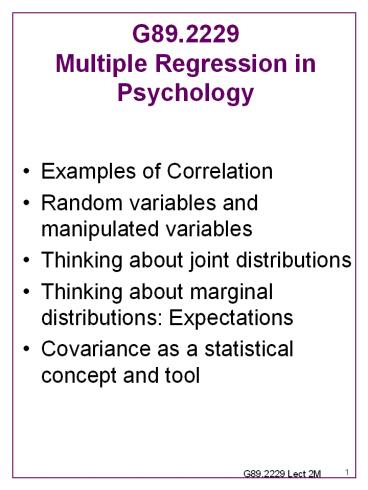Examples%20of%20Correlation - PowerPoint PPT Presentation
Title:
Examples%20of%20Correlation
Description:
The population moments of the variable are described with Expectation Operators. Expectation operators can be used to study means and variances. ... – PowerPoint PPT presentation
Number of Views:91
Avg rating:3.0/5.0
Title: Examples%20of%20Correlation
1
G89.2229 Multiple Regression in Psychology
- Examples of Correlation
- Random variables and manipulated variables
- Thinking about joint distributions
- Thinking about marginal distributions
Expectations - Covariance as a statistical concept and tool
2
Three examples of correlation
- All from bar exam study discussed last week
- Anxiety and Depression from POMS on day 29 (two
days before bar exam) - Anger and Vigor from POMS on day 29 (two days
before bar exam) - Anxiety and day to exam during week prior to
start of exam.
3
Anxious and Depressed Mood 2 Days Before Exam
r 0.64
- What do you notice about joint distribution?
- What is correlation?
4
Anger and Vigor 2 Days Before Exam
r -.19
- What do you notice about joint distribution?
- What is correlation?
5
Anxious Mood in Days Before the Exam
r .25
- What do you notice about joint distribution?
- What is correlation?
6
Random Variables vs. Manipulated Variables
- A random variable is a quantity that is not known
exactly prior to data collection. - E.g. anxiety and depression on any given day for
a randomly selected subject - A manipulated variable is a quantity that is
determined by a sampling plan or an experimental
design. - E.g. Day to exam, level of exposure, gender
- This distinction will have implications on
statistical analysis of bivariate association.
7
Thinking about bivariate (Joint) distributions
- Suppose we sample persons and measure two
behaviors. - Both are random
- The variables might be related or independent
- The joint distribution contains information about
each variable and the relation among them. - When we ignore one of the two variables, and
study the other, we say we are studying the
Marginal distribution - This term simply reminds us that another variable
is in the background
8
Expectations and Moments for Marginal
Distributions
- Suppose we measure X, and Y, but choose to study
only X (ignoring Y). - We can describe the marginal distribution of X
using the mean, the variance, and other moments
such as coefficient of skewness and kurtosis. - The population moments of the variable are
described with Expectation Operators. - Expectation operators can be used to study means
and variances.
9
Expectation operators defined
- The population mean, m E(X), is the average of
all elements in the population. - It can be derived knowing only the form of the
population distribution. - Let f(X) be the density function describing the
likelihood of different values of X in the
population. - The population mean is the average of all values
of X weighted by the likelihood of each value. - If X has finite discrete values, each with
probability f(X)P(X), E(X)S P(xi)xi - If X has continuous values, we write E(X) ò x
f(x) dx
10
Rules for Expectation operators
- E(X)mx is the first moment, the mean
- Let k represent some constant number (not random)
- E(kX) kE(X) kmx
- E(Xk) E(X)k mxk
- Let Y represent another random variable (perhaps
related to X) - E(XY) E(X)E(Y) mx my
- E(X-Y) E(X)-E(Y) mx - my
- Putting these together
- E( ) E(X1X2)/2 (m1 m2)/2 mThe
expected value of the average of two random
variables is the average of their means.
11
Variance Operators
- Analogous to E(Y)m, is V(Y)E(Y-m)2 ò (y -
m)2f(y) dy - E(X-mx)2 V(X) sx2
- Let k represent some constant
- V(kX) k2V(X) k2sx2
- V(Xk) V(X) sx2
- Let Y represent another random variable that is
independent of X - V(XY) V(X)V(Y) sx2 sy2
- V(X-Y) V(X)V(Y) sx2 sy2
- A more general form of these formulas requires
the concept of covariance
12
Covariance A Bivariate Moment
- E(X-?x)(Y-?y) Cov(X,Y) ?XY is called the
population covariance. - It is the average product of deviations from
means - It is zero when the variables are linearly
independent - Formally it depends on the joint bivariate
density of X and Y, f(X,Y). - f(X,Y) says how likely are any pair of values of
X and Y - Cov(X,Y) ò ò(X-?x)(Y-?y)f(X,Y)dXdY
13
Cov (X,Y) as an expectation operator
- For k1 and k2 as constants, there are facts
closely parallel to facts for variances - Cov(k1X, k2Y) Cov(X,Y) ?XY
- Cov(k1X, k2Y) k1k2Cov(X,Y) k1k2 ?XY
- Important special case
- Let Y (1/?Y)Y and X (1/?X)X V(X)
V(Y) 1.0 - Cov(X,Y) (1/?Y) (1/?X) ?XY ?XY
- Cov (X,Y) is the population correlation for the
variables X and Y, ?XY - Since ?XY (1/?Y) (1/?X) ?XY, ?XY (?Y) (?X)
?XY
14
An important use of correlation and covariance
- We are often interested in linear functions of
two random variables aXbY - a1, b1 gives sum
- a.5, b.5 gives average
- a1, b-1 gives difference
- What is the expected variance of WaXbY in
general? - Var(W) V(aXbY) a2 V(X)b2 V(Y) 2ab
Cov(X,Y) a2 sx2 b2 sy2 2ab sx sy rxy - This can be used to compute expected standard
error of contrasts of sample statistics.
15
Example
- Suppose we want to average the POMS anxious and
depressed moods. What is the expected variance? - In the sample on day 29,
- Var(Anx)1.129, Var(Dep)0.420Corr(A,D)
0.64Cov(A,D).64(1.129.420)1/2 0.441 - Var(.5A.5D) .(25)(1.129)(.25)(.420)
(2)(.25)(.441) 0.648
16
Final Comment
- Standard deviations and variances are
particularly useful when variables are normally
distributed - Expectation operators assume that f(X), f(Y) and
f(X,Y) can be known, but they do not assume that
these describe bell shape or normal distributions - Covariances and correlations can be estimated
with non-normal variables, but be careful about
statistical tests.































